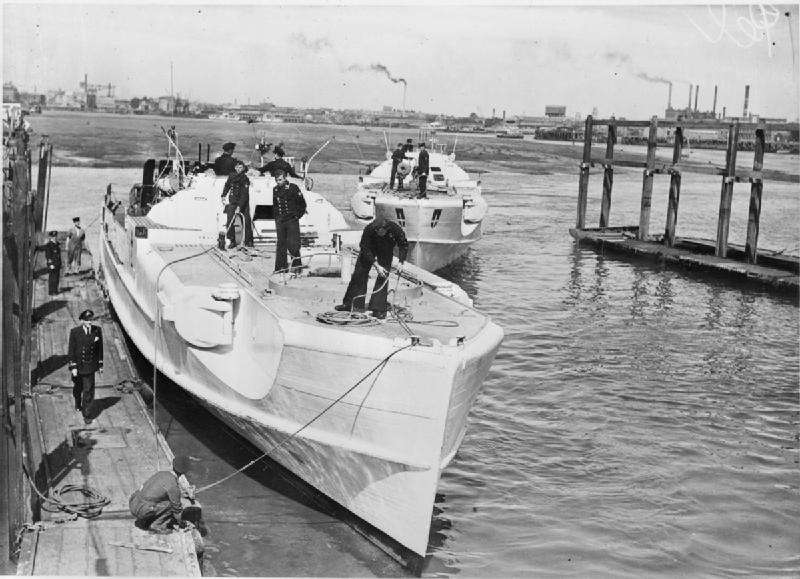German E-Boats, also known as S-Boats (Schnellboote), were high-speed torpedo boats extensively deployed by the Kriegsmarine in World War II.

Celebrated for their speed, durability, and combat prowess, these high-speed torpedo boats, deployed extensively by the Kriegsmarine, left an indelible imprint on the battlefields of the North Sea, English Channel, and Western Approaches, orchestrating swift strikes and adept retreats.
Genesis And Design Of The E-Boats
The decision to utilize this particular design was driven by the anticipated operational environment of these boats, which was forecasted to be the North Sea, English Channel, and Western Approaches.
The necessity for superior performance in harsh sea conditions necessitated the selection of a round-bottomed displacement hull, diverging from the typical flat-bottomed planing hull common in smaller, high-speed boats.
The Lürssen shipbuilding company managed to mitigate numerous drawbacks associated with this type of hull.
The result was the Oheka II, a vessel that exhibited speed, robustness, and seaworthiness.
These characteristics caught the attention of the Reichsmarine, leading to a 1929 order for a similar craft, but equipped with two torpedo tubes.
This model, known as the S1, set the foundation for all future E-boats.
The E-boats were constructed with a hard-chine, planing hull, a design that allowed the boats to skim over the water at high speeds rather than pushing through it.
This approach significantly reduced drag and increased overall performance.
The E-boat design had a distinctive ‘S’-shape, giving the boat a low profile to reduce visibility and make it a harder target for enemy ships and aircraft.
It also had the added advantage of keeping the deck as dry as possible, improving stability and handling.
Furthermore, the shape of the hull was such that it could cut through waves, allowing the boats to maintain their high speed even in relatively rough seas.
The hulls were crafted from light metal alloys to further reduce weight and increase speed.

A German Schnellboot prior to the Second World War.
These boats were powered by three supercharged, twelve-cylinder Daimler-Benz MB501 diesel engines, each producing 2000 horsepower.
This immense power propelled the E-boats to speeds of up to 40 knots (46 mph), making them one of the fastest military vessels of their time.
In terms of dimensions, the E-boats were not large craft. They measured about 35 meters (115 feet) in length, with a beam of roughly 5 meters (16 feet), and a draught of 1.67 meters (5.5 feet).
Despite their relatively small size, they could carry substantial armament and had a crew of 32 men.
The design of the E-boat was continuously improved upon throughout the war. Later models were larger, faster, and better armed.
The culmination of these improvements was the S-100 class, which entered service in 1943 and remained in service through the end of the war.
They represented the apex of E-boat development and were regarded as some of the finest torpedo boats of the Second World War.
Armament
The armament of the German E-boats evolved and adapted as the circumstances of World War II changed.
Their primary weapon was the torpedo, with the boats initially fitted with two torpedo tubes. The torpedoes used were the 53.3 cm G7a and G7e models.
The former was steam-powered, with a range of about 9.9 kilometers at 44 knots, while the latter was electric, with a range of around 5 kilometers at 30 knots.
The torpedoes could inflict devastating damage on enemy vessels. The E-boat tactics often relied on launching a swift, unexpected strike, unleashing torpedoes, and then swiftly retreating before the enemy could respond.
This hit-and-run tactic allowed the E-boats to punch well above their weight, often causing havoc amongst much larger enemy fleets.
In addition to torpedoes, the E-boats were also armed with 20mm anti-aircraft guns for protection against aerial threats. As the war progressed and the Allies established air superiority, the threat from the air increased, and the E-boats adapted to counter this.
More guns were added, including the powerful 37mm and 40mm anti-aircraft guns, and the boats’ superstructure was modified to accommodate these new weapons.
By the latter stages of the war, the E-boats were also carrying mines for laying in enemy waters. This added another dimension to their offensive capabilities.
 A German E-Boat after surrendering, on its way to Gosport.
A German E-Boat after surrendering, on its way to Gosport.
The E-boats could dash into enemy-held waters, lay their mines, and retreat before the enemy knew what had happened.
These mines could then cause significant damage to enemy shipping, adding to the E-boat’s disruptive potential.
Another adaptation was the fitting of radar sets onto the E-boats. These sets improved the boats’ ability to find and track enemy vessels, especially in poor visibility.
This enabled the E-boats to remain effective even in the challenging conditions of the North Atlantic.
The German E-boats were also equipped with radio communication devices for coordination during their group attacks and operations.
These devices evolved from simple voice radios to more complex systems capable of encrypted communications to safeguard their operational plans.
Despite their smaller size, the E-boats could carry a surprising amount of fuel and supplies, enabling them to undertake long-range operations. The large fuel tanks allowed them to roam far from their bases, extending their area of operations.
Notable Missions And Battles
Throughout World War II, the German E-boats were involved in several major missions and battles, earning a reputation for their effectiveness in maritime warfare.
Battle of the Atlantic
The E-boats played a significant role in the Battle of the Atlantic, the longest continuous military campaign during World War II.
Their mission was to disrupt the Allied supply lines between North America and Europe, and they frequently targeted convoys carrying critical supplies and troops.
Utilizing their high speed and stealth, they would launch surprise attacks on these convoys, often causing significant losses before slipping away.
Channel Dash
The E-boats were instrumental in Operation Cerberus, also known as the Channel Dash, in February 1942.
This daring operation involved escorting the German battleships Scharnhorst, Gneisenau, and the heavy cruiser Prinz Eugen from Brest, France, through the English Channel to their home bases in Germany.
 A pair of surrendered German E-Boats after arriving at HMS Hornet.
A pair of surrendered German E-Boats after arriving at HMS Hornet.
Despite being heavily outnumbered and operating in a very narrow and heavily patrolled sea lane, the E-boats were there to protect the larger ships from attack, ensuring their safe passage.
Exercise Tiger
One of the most infamous operations involving the E-boats was their attack on Exercise Tiger in April 1944.
Exercise Tiger was a large-scale rehearsal for the upcoming D-Day invasion, involving thousands of troops in Lyme Bay, England.
Responding to increased radio traffic, nine E-boats launched a surprise attack on the Allied forces, sinking two landing ships and causing over 700 casualties among American servicemen.
Post D-Day Operations
Following the successful D-Day landings in June 1944, the E-boats continued their disruptive activities against the Allied forces.
They conducted numerous hit-and-run attacks on Allied supply lines, targeting convoys bringing supplies and reinforcements to the Normandy beachhead.
Despite the Allies’ air superiority and substantial naval presence, the E-boats managed to continue their operations, earning them the nickname ‘D-Day Dodgers.’
Operational Challenges
However, the operational history of the E-boats was not without challenges. The highly-tuned engines that provided the E-boats with their remarkable speed required significant maintenance.
This was a significant issue, especially as Germany’s resources became increasingly strained as the war went on.
Additionally, the high-performance engines were noisy, which could give away the position of the E-boats.
This was a problem because the effectiveness of the E-boats relied heavily on their ability to approach the enemy undetected.
Another challenge faced by the E-boats was their seaworthiness in rough weather.
The narrow hull and lightweight design that allowed for high speeds and agility in calm weather could become a liability in heavy seas.
The E-boats struggled to maintain their operational effectiveness in these conditions, which could limit their ability to carry out missions.
Moreover, despite their speed and maneuverability, E-boats were vulnerable to air attacks.
The Allies air superiority made operations increasingly risky for the E-boats.
Finally, the E-boats had limited endurance due to their high fuel consumption at top speeds.
This meant that their operational range was relatively limited, and they often had to operate relatively close to their bases.
Legacy Of The E-Boats
As World War II came to a close, the era of the German E-boats, like that of the Third Reich, ended.
However, their legacy lived on, influencing the development of naval warfare tactics and the design of small, fast attack crafts for decades to come.
By 1945, the E-boats had suffered heavy losses. Allied air superiority, improved anti-submarine warfare techniques, and the sheer attrition of continuous combat had greatly reduced their number.
Many surviving E-boats were scuttled by their crews to prevent them from falling into Allied hands, while others were seized.
However, despite their loss, the influence of the E-boats did not end with the war.
The lessons learned from their use had a significant impact on naval strategy and tactics.
The E-boats’ effectiveness at hit-and-run attacks and their ability to disrupt enemy operations, despite being heavily outnumbered, influenced the development of post-war naval doctrines.
They showed the value of small, fast, and heavily armed vessels that could inflict disproportionate damage on larger and more heavily armed opponents.
Their design principles also found their way into the development of post-war vessels.
The hard-chine planing hull design, the use of lightweight materials, and the focus on high-speed engines influenced the design of many types of fast attack craft in the post-war era.
 A German E-Boat S 204 after being escorted to HMS Beehive, 13 May 1945.
A German E-Boat S 204 after being escorted to HMS Beehive, 13 May 1945.
In fact, some E-boats were reused after the war. Several were taken over by the Soviet Navy and served for many years.
Others found their way into the naval forces of France, Norway, and other countries. Their continued service post-war is a testament to their robust design and effectiveness.
Today, the E-boats are remembered as one of the most effective weapons of the Kriegsmarine.
Their operational history serves as a reminder of their impact on the outcome of World War II and their influence on modern naval warfare.
They represent an important chapter in the history of naval warfare, a chapter that combines innovative design, daring tactics, and the harsh reality of war.





